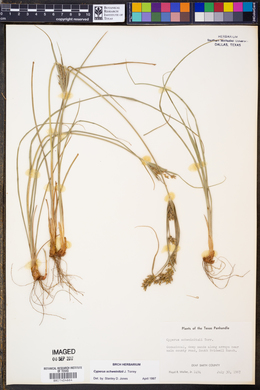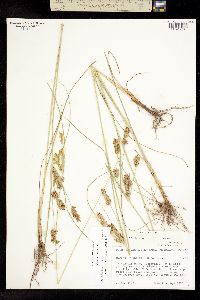Cyperus schweinitzii
|
|
|
|
Family: Cyperaceae
Sand Flat Sedge, more...Schweinitz's flatsedge
[Cyperus schweinitzii var. uberior Kükenth., moreMariscus schweinitzii (Torr.) T. Koyama] |
Herbs, perennial, rhizomatous. Culms trigonous, (10-)20-50 cm × (0.6-)1-2 mm, glabrous or more often scabridulous, either in distal 1/2 or over entire length; basal sheaths, 1-3, light brown, 1-4 cm, papery. Leaves flat to V-shaped, (2-)20-35 cm × 2-6 mm, margins and keel minutely scabridulous; proximal leaves bladeless. Inflorescences: spikes ± umbellate to slenderly (infrequently broadly) ovoid, 10-25 × 7-16 mm; rays 3-5, 1.5-8(-15) cm; bracts 3-7, erect (or declined at most 25-30° from vertical), (2.5-)8-20(-25) cm × (0.5-)1.5-6 mm; rachilla ± deciduous, wingless. Spikelets (1-)5-10(-20), oblong to linear-oblong, quadrangular, 7-10(-18) × (2.8-)3.2-4(-4.5) mm; floral scales deciduous, (1-)5-10(-14), spreading, laterally stramineous or dull whitish, sometimes also red-spotted, medially green, laterally 2-3-ribbed, medially 3-ribbed, broadly ovate to oblong-ovate, (2.3-)2.8-3.2 × (2-)2.4-3.2 mm, apex broadly rounded, often clear-erose, cusp 0.1-0.4 mm in proximal scales, 0.3-1 mm in distal scales. Flowers: anthers 0.8-1.4 mm; styles 0.1-0.3 mm; stigmas 1.5-3 mm. Achenes light to dark brown or nearly black, broadly ellipsoid, infrequently obovoid, 2-2.4 × 0.9-1.4 mm, base cuneate to ± stipelike, apex obtuse to broadly rounded, surfaces papillose. 2n = 166. Fruiting late spring-early summer. Riverbanks, sand bars, lakeshores, sand dunes, sandy openings in woods; 0-1000 m; Alta., Man., Ont., Que., Sask.; Colo., Ill., Iowa, Ky., Mass., Mich., Minn., Mo., Mont., N.J., N.Mex., N.Y., Ohio, Okla., Pa., S.Dak., Tex., Utah, Wash., Wis., Wyo.; Mexico (Coahuila). Cyperus schweinitzii is introduced, but not naturalized, in Massachusetts and Washington.
Perennial herb with short, knotty rhizomes 10 cm - 1 m tall Leaves: alternate, 20 - 35 cm long, 2 - 8 mm wide, flat or V-shaped in cross-section, linear, parallel-veined, keeled beneath, with a sheathing base that encloses the stem. Basal sheaths one to three, light brown, 1 - 4 cm long, papery. Basal leaves bladeless. Inflorescence: consisting of terminal spikes, subtended by spirally arranged leafy bracts. Bracts three to seven, upright, unequal, 8 - 20 cm long, 1.5 - 6 mm wide, much longer than inflorescence. Rays (branches of inflorescence) three to five (some spikes stalkless), 1.5 - 10 cm long. Spikes 1 - 2.5 cm long, 7 - 16 mm wide, reverse conic to oblong, consisting of five to fifteen spikelets. Flowers: minute, in the axil of a floral scale, lacking sepals and petals. Stamens exserted. Anthers to 1.5 mm long. Pistil one. Style under 0.5 mm long. Stigma 1.5 - 3 mm long. Fruit: a one-seeded achene, brown to almost black, 2 - 3 mm long, 1 - 1.5 mm wide, widely ellipsoid with a tapering or more or less stalk-like base and rounded apex, three-angled, bumpy. Seed with a thin, non-adherent wall. Culm: 10 cm - 1 m long, 1 - 2.5 mm wide, triangular in cross-section, solid, often rough above. Spikelets: ascending, 0.5 - 2.5 cm long, 3 - 4.5 mm wide, four-angled, flattened, oblong, subtended by two small bracts, with five to ten floral scales. Scales five to ten, spreading, straw-colored or whitish along the sides, sometimes red-dotted, green down the middle, 2.5 - 3.5 mm long, 2.5 - 3 mm wide, widely egg-shaped to oblong egg-shaped with a broadly rounded apex bearing a tiny point, two- to three-ribbed along the sides, three-ribbed down the middle, lowest one empty. Similar species: No information at this time. Flowering: June to late August Habitat and ecology: Found in disturbed sandy soil, cindery road ballast, and sandy Black Oak savannas. Occurence in the Chicago region: native Etymology: Cyperus is the ancient Greek word for sedge. Schweinitzii is named after Lewis David de Schweinitz (1780-1834), the botanist who discovered this species. Author: The Morton Arboretum Perennial from short, knotty rhizomes; stems 1-10 dm, scabrous above on the sides and sharp angles, 1-2.5 mm thick below the infl; lvs basally disposed, 2-8 mm wide, scabrous on the margins; bracts 3-8, strongly ascending, usually much longer than the infl; sessile spike obconic to oblong; rays 1-8, rarely over 10 cm; spikelets 5-15 in the sessile spike, fewer in the reduced ones, all crowded, ascending, flattened, 5-25 נ3-4.5 mm, 5-18-fld; scales broadly ovate-elliptic to rotund, the body 2.5-3.5 mm, in half-view nearly or fully as wide as long, multinerved, with a conspicuous mucro 0.5-1 mm; rachilla wingless or nearly so; anthers 0.6-1 mm; achenes dark, trigonously oblong with plane or only slightly concave faces, 2-3 mm, half as thick; 2n=ca 166. Sandy soil; Mass. and Que. to Minn., s. and w. to N.J., O., Mo., Utah, N.M., and adj. Mex. Gleason, Henry A. & Cronquist, Arthur J. 1991. Manual of vascular plants of northeastern United States and adjacent Canada. lxxv + 910 pp. ©The New York Botanical Garden. All rights reserved. Used by permission. From Flora of Indiana (1940) by Charles C. Deam This species grows in very dry sand and has its mass distribution on the dunes near Lake Michigan. The Warren County specimen was found on the very high, gravelly bank along the Big Four Railroad about 2 miles northwest of Covington. |
|
|
|
































































































